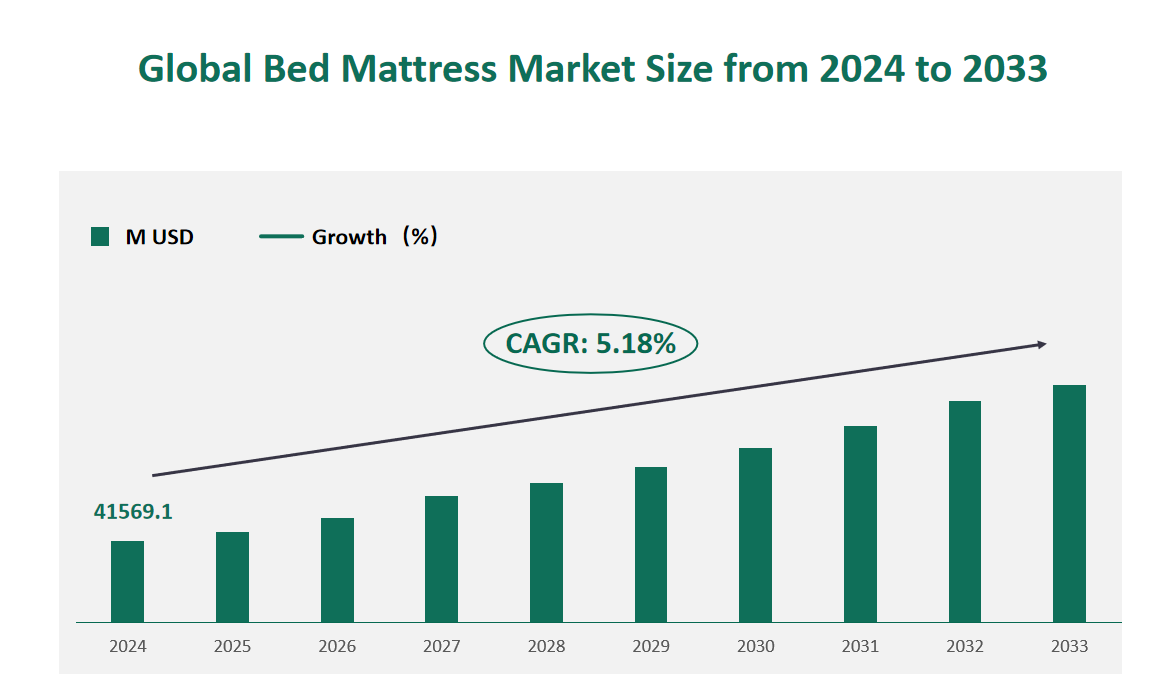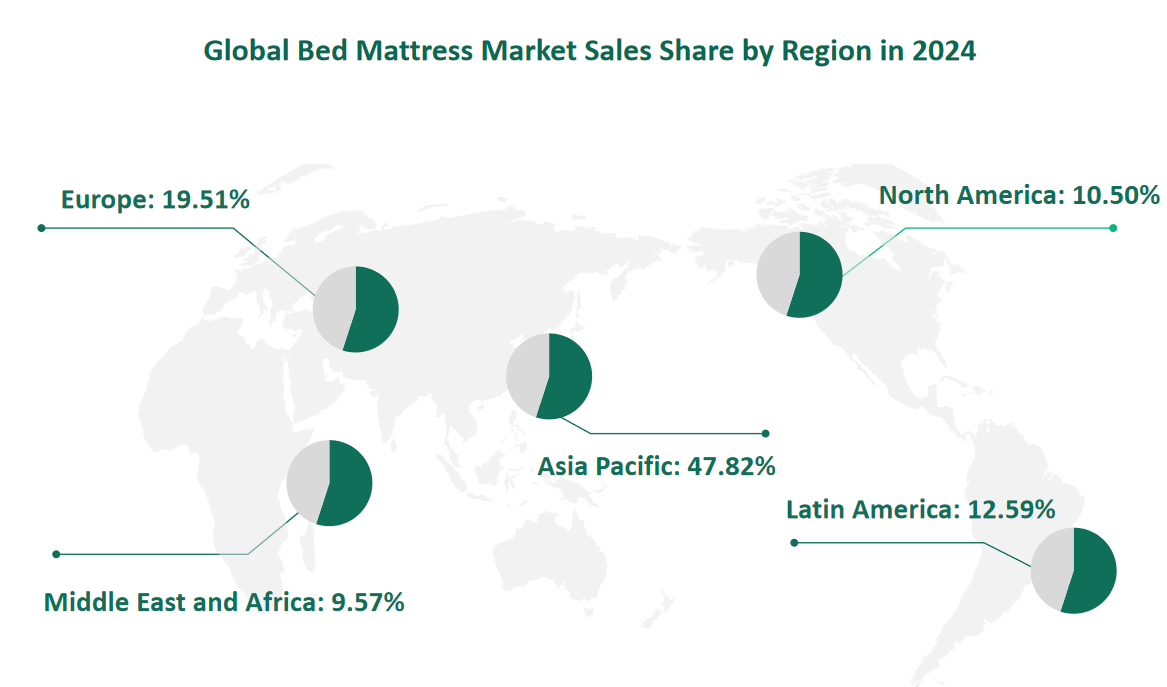1 Global Bed Mattress Market Size (Value) and CAGR (2024-2033)
In 2024, the global Bed Mattress market was valued at USD 41569.1 million in 2024, with a CAGR of 5.18% from 2024 to 2033.
The bed mattress market encompasses a variety of products designed to provide comfort and support during sleep. A bed mattress, at its core, is a rectangular pad intended to support an individual while lying down, typically as part of a bed or on a bed frame. Mattresses are crafted from an array of materials, including cotton, foam rubber, or metal springs, each conferring distinct sleeping qualities and experiences. The diversity in materials used has led to the classification of mattresses into several types, such as foam mattresses, coil or innerspring mattresses, latex mattresses, hybrid mattresses, and others.
Figure Global Bed Mattress Market Size (M USD) and CAGR 2024-2033

2 Bed Mattress Market Drivers and Trends
The bed mattress market is experiencing significant growth, propelled by several key drivers and trends. One of the primary growth drivers is the increasing focus on sleep health and the rise of the sleep economy. With insomnia affecting a substantial portion of the global population, there is a growing demand for mattresses that enhance sleep quality and provide personalized comfort. The integration of technology in mattress design has led to the development of smart mattresses, which offer features like sleep tracking and health diagnostics, further driving market growth.
Another significant trend is the development of e-commerce, which has revolutionized the way mattresses are sold. The convenience of online shopping, coupled with the ability to compare products and read reviews, has made it easier for consumers to purchase mattresses directly from manufacturers.
The market is also witnessing a trend towards product diversification and personalization. Consumers are increasingly seeking mattresses that cater to their specific needs and preferences, leading to the emergence of a wide range of mattress types, including memory foam, latex, and hybrid models. Manufacturers are investing in research and development to create innovative products that meet these evolving consumer demands.
3 Bed Mattress Market Challenges and Restraints
Despite the promising growth, the bed mattress market faces several challenges and restraints. Intense market competition is a significant challenge, with new entrants and established players vying for market share. This competition often leads to price wars, which can erode profit margins and hinder sustainable growth. Additionally, the market is characterized by a low concentration rate, with the top three companies holding less than 20% of the market share, indicating a fragmented market landscape.
Another challenge is the high durability of mattresses, which might restrain the market growth. Mattresses are long-lasting products, and once purchased, they are not frequently replaced, which limits the frequency of purchases and thus the market growth. This is particularly pronounced in developing countries where consumers often keep their mattresses until they are no longer usable.
The market is also susceptible to raw material price fluctuations, which can impact profitability. Mattress manufacturers are highly dependent on external supplies of raw materials, and any increase in the cost of these materials can significantly affect the final product’s price.
4 Global Bed Mattress Market Sales (K Units) and Share by Type in 2024
In 2024, the global bed mattress market is anticipated to showcase a diverse landscape with various types of mattresses catering to different consumer preferences and needs.
Foam Mattress: Foam mattresses, which accounted for a significant share of the market, are made from petrochemical-based flexible polyurethane foams and viscoelastic foams or memory foam. These mattresses are known for their ability to conform to the body’s shape, providing pressure relief and support. In 2024, the sales of foam mattresses are forecasted to reach 58,213 K Units, reflecting a steady demand for this type of mattress due to its comfort and durability.
Coils or Innerspring Mattress: Innerspring mattresses, the most traditional type, consist of a core made up of springs and coils. They are valued for their good elasticity, support, breathability, and durability. The market scale for innerspring mattresses in 2024 is projected to be 98,783 K Units, indicating the enduring preference for this classic mattress type among consumers.
Latex Mattress: Latex mattresses, either synthetic or natural, offer a unique sleeping experience. Natural latex, derived from rubber trees, is especially sought after for its softness, comfort, and ventilation properties. The market scale for latex mattresses in 2024 is estimated at 32,223 K Units, highlighting a niche but loyal consumer base that appreciates the natural and hypoallergenic qualities of latex.
Hybrid Mattress: Hybrid mattresses combine the best of both worlds, typically featuring a mix of materials such as innerspring coils and foam or latex layers. They aim to provide the support of coils with the pressure relief of foam, making them a popular choice for those seeking a balanced sleep surface. The sales of hybrid mattresses in 2024 are expected to reach 44,662 K Units, reflecting the growing trend towards hybrid mattresses.
Table Global Bed Mattress Market Sales (K Units) and Share by Type in 2024
Type | Market Sales (K Units) 2024 | Market Share 2024 |
Foam Mattress | 58213 | 22.35% |
Coils or Innerspring Mattress | 98783 | 37.92% |
Latex Mattress | 32223 | 12.37% |
Hybrid Mattress | 44662 | 17.14% |
Others | 26622 | 10.22% |
5 Global Bed Mattress Market Sales (K Units) and Share by Application in 2024
In 2024, the sales figures for different applications provide a clear picture of the Bed Mattress market’s demand and growth potential.
Private Households: This segment dominates the market, with sales projected to reach 166,310 K Units in 2024. Private households are the primary consumers of bed mattresses, seeking comfort and durability for personal use. This application’s large market scale reflects the fundamental need for sleep comfort in residential settings.
Hotels: The hospitality industry is a significant market for bed mattresses, with sales expected to be 39,145 K Units in 2024. Hotels require mattresses that provide a consistent and high-quality sleeping experience for guests, often opting for mattresses that balance comfort with longevity to withstand heavy use.
Hospitals: The healthcare sector, particularly hospitals, represents a niche market for bed mattresses, with an estimated 28,304 K Units to be sold in 2024. Mattresses for hospitals must meet strict hygiene and comfort standards, as they cater to the needs of patients with varying health conditions.
Table Global Bed Mattress Market Sales (K Units) and Share by Application in 2024
Application | Market Sales (K Units) 2024 | Market Share 2024 |
Private Households | 166310 | 63.84% |
Hotels | 39145 | 15.03% |
Hospitals | 28304 | 10.87% |
Others | 26744 | 10.27% |
6 Global Bed Mattress Market Sales (K Units) and Share by Region in 2024
In 2024, the sales figures for different regions offer a glimpse into the Bed Mattress market’s geographical distribution and potential for growth.
North America: With a market share of 10.50% in 2024, North America is expected to sell 27,347 K Units of bed mattresses. This region has a mature market with a high penetration of mattress consumption, driven by a large population and a strong economy.
Europe: Europe is projected to have a market share of 19.51%, with sales reaching 50,834 K Units in 2024. The region’s market is influenced by its diverse countries, each with its own consumer preferences and economic conditions, contributing to a mixed but significant market presence.
Asia Pacific: This region is expected to dominate the market with a share of 47.82%, selling 124,570 K Units in 2024. The rapid economic growth, increasing middle class, and urbanization in countries like China and India have led to a surge in demand for bed mattresses in the Asia Pacific region.
Latin America: Latin America is projected to sell 32,810 K Units, holding a market share of 12.59% in 2024. The region’s market is growing, albeit at a slower pace compared to Asia Pacific, with countries like Brazil and Mexico contributing significantly to the regional demand.
Middle East and Africa: With a market share of 9.57%, this region is expected to sell 24,942 K Units in 2024. The market in the Middle East and Africa is influenced by economic fluctuations and varying consumer preferences across its diverse countries.
Figure Global Bed Mattress Market Share by Region in 2024

7 Major Players in Global Bed Mattress Market
7.1 Tempur Sealy International
Company Profile: Tempur Sealy International, established in 2012 and headquartered in the USA, is a leading manufacturer of mattresses and bedding products. The company was formed through the acquisition of Sealy Corporation by Tempur-Pedic International, creating a powerhouse in the bed mattress industry with a worldwide market distribution.
Business Overview: Tempur Sealy International is known for its innovative sleep products, including memory foam mattresses. The company operates on a global scale, offering a diverse range of products that cater to different consumer preferences and needs. With a strong focus on research and development, Tempur Sealy continues to push the boundaries of sleep technology.
Product Portfolio: The company’s product lineup includes the TEMPUR-Cloud® mattress, known for its medium feel and superior conforming comfort, and the TEMPUR-Cloud® Medium Hybrid mattress, which combines the benefits of memory foam with premium spring coils. These products are designed to provide pressure-relieving support and motion isolation for a restful night’s sleep.
Financials (2022): Tempur Sealy International reported revenues of $3,542 million USD in 2022, with a gross margin of 39.55%.
7.2 Serta Simmons Bedding
Company Profile: Serta Simmons Bedding, with a history dating back to 1870 and headquartered in the USA, is a renowned manufacturer of mattresses and bedding products. The company has a global reach and is committed to delivering the latest innovations in sleep products and technology.
Business Overview: Serta Simmons Bedding offers a wide array of bedding products, including innerspring, specialty foam, and hybrid mattresses. The company is dedicated to providing consumers with a variety of choices to meet every sleep preference, making it a popular choice in the mattress market.
Product Portfolio: Among their products is the Serta EZ Tote Mattress, which offers quality comfort in a compact package. This mattress combines cooling Serta® Gel Memory Foam with a durable Serta® Foam Core for supportive comfort that lasts all night.
Financials (2022): In 2022, Serta Simmons Bedding achieved revenues of $2,239.1 million USD, with a gross margin of 39.75%.
7.3 Sleep Number
Company Profile: Sleep Number, formerly Select Comfort Corporation, was established in 1987 and is based in the USA. The company is a designer, manufacturer, marketer, retailer, and servicer of Sleep Number beds, offering individualized sleep solutions and services.
Business Overview: Sleep Number Corporation is known for its adjustable beds that provide customized comfort and support. The company has a strong presence mainly in North America and is dedicated to enhancing the sleep experience through innovation and technology.
Product Portfolio: The Sleep number 360® c2 smart bed is a standout product, featuring adjustable comfort and firmness on each side, automatic adjustment based on movement, and the ability to show sleep quality with personal insights for better sleep.
Financials (2022): Sleep Number reported revenues of $1,409.3 million USD in 2022, with a gross margin of 41.40%.

